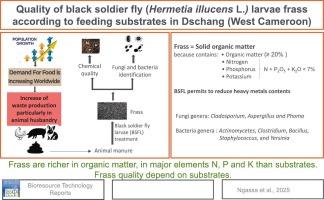喀麦隆西部Dschang地区不同取食基质黑兵蝇幼虫质量调查
Q1 Environmental Science
引用次数: 0
摘要
全球人口的增长不仅要求粮食产量大幅增加,而且还导致废物产量增加,特别是在畜牧业中。面对这一挑战,可持续农业的创新废物转化技术已经出现,例如昆虫幼虫,特别是黑虻(Hermetia illucens L.)对废物的生物转化。黑兵蝇幼虫作为一种有价值的蛋白质来源在饲料中越来越受到关注,而其残馀的草渣则被用作有机肥。然而,它的性质还没有被很好地理解。该工作旨在表征取食基质和相应的杂草,重点是它们的化学和微生物特性。对作为底物的动物粪便和产生的杂草进行取样和分析。用分光光度法进行化学分析。真菌和细菌根据其形态和培养特征进行鉴定。结果表明,猪粪产生的幼虫最多,产生的粪质最多。与各取食基质相比,草叶中有机质、有机碳、全氮、全磷、全钾含量较高。BSFL处理也降低了粪便中重金属的含量。微生物学分析显示,除猪粪外,其余真菌主要为枝孢菌属、曲霉属和霉属。鉴定的细菌包括放线菌、梭状芽孢杆菌、葡萄球菌、芽孢杆菌和耶尔森菌。值得注意的是,BSFL消除了所有样品中的放线菌。这些发现突出了BSFL作为废物管理和废物生产的有效解决方案的潜力。本文章由计算机程序翻译,如有差异,请以英文原文为准。

Quality of black soldier fly (Hermetia illucens L.) larvae frass according to feeding substrates in Dschang (West Cameroon)
The global population growth not only requires a significant increase in food production but also leads to an increase in waste production especially in livestock farming. Facing this challenge, innovative waste transformation techniques for sustainable agriculture have emerged, such as the bioconversion of waste by insect larvae, particularly the black soldier fly (Hermetia illucens L.). Black soldier fly larvae (BSFL) are gaining attention as a valuable protein source in animal feed while the residues, frass, are used as organic fertilizer. However its properties are not well understood. The work aimed to characterize the feeding substrates and the corresponding frass focusing on their chemical and microbiological properties. The animal droppings used as substrates, and the resulting frass were sampled and analyzed. Chemical analyses were performed using spectrophotometry. Fungi and bacteria were identified based on their morphological and cultural characteristics. The results showed that pig manure produced the biggest larvae and the greatest quantity of frass. Compared to the respective feeding substrates, the frass contained higher levels of organic matter, organic carbon, total nitrogen, phosphorus and potassium. Treatment with BSFL also reduced the heavy metal contents in the manure. Microbiological analysis revealed fungi from the genera Cladosporium, Aspergillus and Phoma except in the pig manure-derived frass. Bacteria identified included species Actinomycetes, Clostridium, Staphylococcus, Bacillus and Yersinia. Notably, BSFL eliminated Actinomycetes in all frass samples. These findings highlight the potential of BSFL as an effective solution for waste management and frass production.
求助全文
通过发布文献求助,成功后即可免费获取论文全文。
去求助
来源期刊

Bioresource Technology Reports
Environmental Science-Environmental Engineering
CiteScore
7.20
自引率
0.00%
发文量
390
审稿时长
28 days
 求助内容:
求助内容: 应助结果提醒方式:
应助结果提醒方式:


